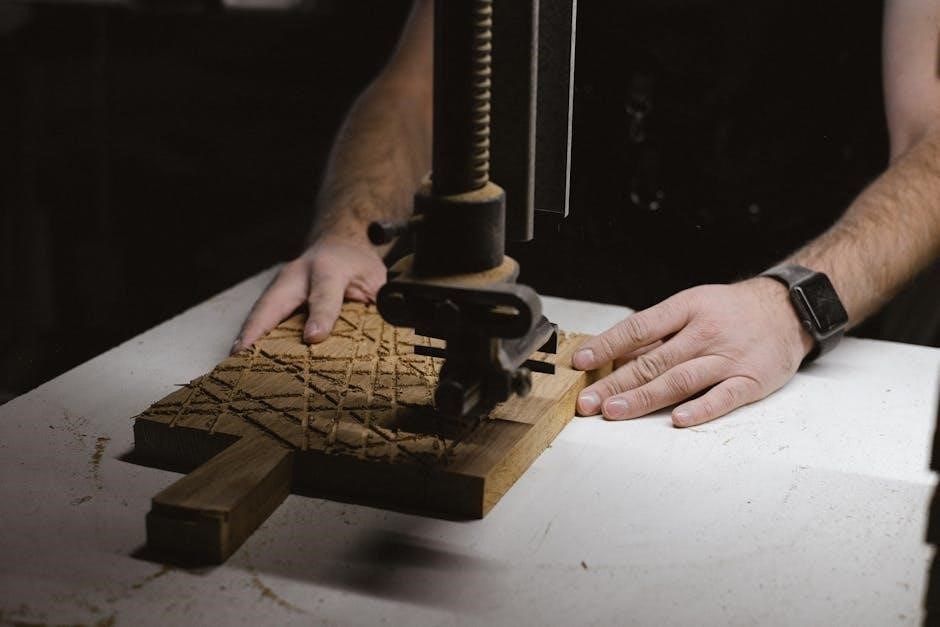The Craftsman Pressure Washer manual provides essential guidance for safe and effective use. It details key features, assembly, operation, and maintenance to ensure optimal performance and longevity of the equipment.
Overview of the Craftsman Pressure Washer

The Craftsman Pressure Washer is a versatile and powerful cleaning tool designed for various tasks, from light household chores to heavy-duty outdoor cleaning. With models like the 2400 PSI high-pressure washer, it offers robust performance for tackling dirt, grime, and tough stains on surfaces such as driveways, decks, and siding. Known for its portability and durability, the Craftsman Pressure Washer features high-quality components and user-friendly designs. It is equipped with adjustable nozzles and tips to cater to different cleaning needs. The device is also designed with safety and efficiency in mind, ensuring minimal water waste and optimal energy use. Regular maintenance, as outlined in the manual, helps extend its lifespan and maintain peak performance. Whether for residential or commercial use, the Craftsman Pressure Washer is a reliable choice for achieving professional-grade cleaning results. Additionally, the manual provides essential tips for environmentally friendly usage, ensuring responsible operation. Always refer to the manual for model-specific details and capabilities to maximize functionality.
Importance of Reading the Instruction Manual

Reading the Craftsman Pressure Washer manual is crucial for safe and effective operation. It provides detailed instructions for assembly, usage, and maintenance, ensuring optimal performance and longevity. The manual highlights essential safety precautions, helping users avoid potential hazards and damage to the equipment. Understanding the proper techniques for using nozzles and tips can enhance cleaning efficiency. Additionally, the manual includes troubleshooting guides to address common issues, reducing downtime and extending the product’s lifespan. By following the manual, users can ensure compliance with warranty conditions and avoid voiding coverage. Proper adherence to the guidelines also promotes environmentally responsible usage. The manual is a comprehensive resource designed to maximize functionality and user satisfaction. Always refer to it before operating the pressure washer for the first time or when encountering unfamiliar features. This ensures a seamless and safe experience. The manual is printed on high-quality paper for clarity and durability, making it an indispensable companion for your Craftsman Pressure Washer.
Key Features of the Craftsman Pressure Washer
The Craftsman Pressure Washer is designed with high-quality components for efficient cleaning. It offers a powerful 2400 PSI output, suitable for various tasks like cleaning driveways, decks, and siding. The washer features interchangeable nozzles, allowing users to adjust spray patterns for different surfaces. Its durable construction ensures long-lasting performance, while the compact design makes it easy to maneuver. The washer is equipped with a reliable engine and a large detergent tank for extended cleaning sessions. Additional features include a 25-foot high-pressure hose for greater reach and a built-in storage compartment for accessories. These features combine to provide a versatile and reliable cleaning solution for both residential and light commercial use. The washer’s robust build and advanced features make it a valuable tool for maintaining outdoor spaces. Its user-friendly design ensures that even first-time users can operate it effectively. With its impressive power and versatility, the Craftsman Pressure Washer is an excellent choice for tackling tough cleaning jobs efficiently.

Safety Precautions
Always wear protective gear and ensure the washer is on a stable surface. Avoid using near open flames or sparks, and store properly to prevent accidents.
General Safety Warnings
Always operate the Craftsman pressure washer with caution to avoid injuries or damage. Never aim the high-pressure jet at people, pets, or delicate surfaces. Wear protective eyewear and gloves to prevent injury from debris or spray. Ensure the area is clear of obstructions and keep children away while operating. Avoid using the pressure washer near open flames, sparks, or flammable liquids. Do not use the machine in enclosed spaces without proper ventilation. Keep the pressure washer on a stable, level surface to prevent tipping. Avoid overreaching or using excessive force, as this could cause loss of control. Use only genuine Craftsman parts to maintain safety and performance standards. Always follow the manufacturer’s guidelines to ensure safe operation and longevity of the equipment.
Protective Equipment Recommendations
Wear appropriate protective gear when operating the Craftsman pressure washer to minimize risks. Safety glasses or goggles are essential to shield your eyes from debris or chemical spray. Gloves provide grip and protect hands from abrasions or cuts. A face mask is recommended when using detergents to avoid inhaling chemicals. Closed-toe shoes or boots are necessary to prevent foot injuries. Ensure all clothing is secure and avoid loose items that could get caught. Keep long hair tied back to maintain clear visibility. Always inspect protective equipment for damage before use. Using proper gear ensures a safer and more comfortable cleaning experience with your pressure washer.
Environmental and Usage Safety Tips
To promote eco-friendly and safe use of your Craftsman pressure washer, follow these guidelines. Always use biodegradable detergents to minimize environmental impact. Avoid spraying plants or animals, as high pressure can cause harm. Keep the area clear of children and pets while operating. Use the correct pressure setting for the surface to prevent excessive water waste. Never direct the nozzle at electrical outlets or sensitive equipment. Avoid using the pressure washer in extreme weather conditions, such as thunderstorms. Properly dispose of cleaning solutions and filters to protect waterways. Regularly inspect hoses and connections to prevent leaks. By adhering to these tips, you can ensure safe, efficient, and environmentally responsible use of your pressure washer.

Assembly and Installation
Unbox and inspect all components. Attach the spray gun, hose, and spray tip. Ensure all connections are secure. Check for any damage or wear. Follow the manual for proper assembly.
Unboxing and Initial Inspection
Begin by carefully unboxing the Craftsman pressure washer and all included accessories. Inspect each component for damage or wear, such as the pump, hose, spray gun, and nozzles. Check the power cord and ensure all connections are intact. Verify that all parts listed in the packing list are present. If any items are missing or damaged, contact Sears customer service immediately. Take this opportunity to familiarize yourself with the machine’s layout and controls. Reading the manual beforehand will help you identify and understand each part. A thorough inspection ensures safety and proper function, preventing potential issues during assembly and use.
Step-by-Step Assembly Instructions
Start by attaching the handle to the main unit using the provided bolts. Ensure it is securely tightened for stability. Next, install the wheels by aligning the axle with the frame and tightening the nuts. Attach the spray gun to the hose, making sure the connections are snug. Connect the high-pressure hose to the pump and the spray gun, ensuring no leaks. If your model includes a detergent tank, mount it according to the manual. Finally, attach any additional accessories like nozzles or tips. Double-check all connections and refer to the manual for specific torque values. Proper assembly ensures safe and efficient operation of the pressure washer.
Connecting to a Water Source
To connect your Craftsman pressure washer to a water source, start by attaching the water inlet hose to the designated port on the machine. Ensure the connection is tight and free of leaks. Next, attach the other end of the hose to a standard garden hose or water supply. Use Teflon tape on threaded connections to prevent leakage. Turn on the water supply slowly to avoid sudden pressure spikes. Check for any leaks around the connections. Ensure the water source is clean and free of debris to maintain optimal performance. If using a screen or filter, install it inline to protect the pump from sediment. Proper water connection is essential for efficient operation.

Operating Instructions
Prime the pump by squeezing the trigger gun until water flows. Use the correct nozzle for the surface. Adjust pressure settings as needed. Maintain a safe distance. Always keep the gun pointed away from people and pets. Avoid using in extreme temperatures. Monitor water flow and adjust spray angle for best results. Regularly check for blockages in nozzles. Turn off the engine and relieve pressure before stopping. Follow these steps for efficient cleaning and optimal performance.
Preparing the Pressure Washer for Use
Start by reading the manual thoroughly to understand the preparation steps. Check all parts for completeness and inspect for any damage. Tighten any loose bolts or connections. Locate the oil dipstick to ensure the oil level is adequate, and add oil if necessary using the type specified in the manual. Check the fuel level and ensure the fuel line is free from kinks or blockages. Use the recommended gasoline type and octane level. Connect a garden hose to the water inlet, ensuring the water pressure is within the recommended range. Clean or replace the water filter to prevent debris from entering the system. Prime the pump by squeezing the trigger gun several times until water flows steadily. For electric models, plug into a grounded outlet with the correct voltage rating. For gas models, ensure the area is well-ventilated and set the choke to the appropriate position. Attach the correct nozzle for your cleaning task and ensure it is free from blockages. Wear safety gear such as eye protection and closed-toe shoes. Clear the area of obstacles and people. Perform a quick test run to check for smooth water flow and any leaks. If everything functions properly, proceed with cleaning. Regular maintenance, such as changing oil and cleaning filters, will help maintain the pressure washer’s efficiency and longevity. Take your time during preparation to ensure safety and optimal performance.
Starting the Pressure Washer
To start the pressure washer, locate the power switch or choke, depending on the model. For gas-powered models, move the choke to the “start” position and pull the recoil starter handle firmly. Once the engine runs, move the choke to the “run” position. For electric models, plug in the unit and flip the power switch. Always ensure the water supply is connected and the wand is equipped with a nozzle. Squeeze the trigger gun to release any pressure in the system. Allow the pump to build up pressure before directing the spray. If the engine sputters or stalls, refer to the troubleshooting section. Never start the unit near an open flame or sparks. Ensure the area is well-ventilated for gas models. If issues persist, consult the manual or contact customer support. Always follow safety guidelines when starting and operating the pressure washer.
Using Different Nozzles and Tips
Selecting the right nozzle or tip is crucial for effective cleaning. The Craftsman pressure washer typically comes with color-coded nozzles: red (0°) for heavy-duty cleaning, yellow (15°) for general use, green (25°) for delicate surfaces, black (40°) for wide-spray cleaning, and white (60°) for light-duty tasks. To change nozzles, pull and twist the current tip counterclockwise, then insert the new one securely. Always use the correct tip for the surface to avoid damage. For example, the red nozzle is too harsh for windows or siding. Experiment with different tips to find the best flow for your task. Regularly inspect nozzles for blockages and clean them with a soft brush or needle. Store extra tips in a protective case to prevent damage or loss. Proper nozzle selection ensures safety and optimal cleaning performance.
Best Practices for Cleaning Various Surfaces
Always test a small area first to ensure the pressure setting won’t damage the surface. For concrete driveways and sidewalks, use a wide-spray nozzle like black (40°) or white (60°) to cover large areas efficiently. For wood decks, reduce pressure to avoid splintering and use a green (25°) or black (40°) nozzle. When cleaning house siding, start from the top and work downward to prevent dirt from streaking. For vehicles, use a soft-bristle brush attachment and a wide-spray nozzle to protect paint. Avoid using high-pressure nozzles near windows, plants, or electrical outlets. Use eco-friendly detergents when necessary, and rinse thoroughly to remove residue. Regular cleaning prevents grime buildup and extends surface life.

Maintenance and Care
Regularly inspect hoses, nozzles, and connections for wear. Replace damaged parts promptly to prevent leaks and maintain performance. Drain the pump after use to avoid corrosion. Store in a dry, cool place. Avoid using abrasive cleaners. Lubricate moving parts seasonally. Follow manufacturer guidelines for part replacements and routine servicing to ensure longevity and optimal function.
Regular Maintenance Checks
Perform routine inspections to ensure optimal performance. Check hoses, nozzles, and connections for signs of wear or damage. Clean or replace filters as needed to maintain water flow. Lubricate moving parts, such as the pump and spray wand, to prevent friction and wear. Inspect the pressure hose for cracks or abrasions and replace it if damaged. Regularly check the oil level in the pump and top it off as required. Store nozzles in a dry place to avoid rust. Inspect the spray gun and wand for blockages and clean them with a small brush or pin. Schedule professional servicing every 500 hours of use to ensure longevity and reliability.
Storing the Pressure Washer
Proper storage is essential to maintain the performance and longevity of your Craftsman pressure washer. After use, ensure the unit is clean and dry. Drain all fuel from the tank if you won’t be using it for an extended period. Store the pressure washer in a cool, dry, and well-ventilated area, away from direct sunlight and moisture. Avoid leaving the hose attached, as this can cause damage or mold. Clean and store the hose separately, coiling it neatly to prevent kinks. Keep all accessories, such as nozzles and tips, in a dry place. Never store the unit with fuel in the tank during winter months, as freezing temperatures can cause damage. Always check for any signs of wear or damage before storing.
Winterization and Seasonal Storage
Winterizing your Craftsman pressure washer is crucial to prevent damage from freezing temperatures. Start by draining all fuel from the tank and running the engine until it stops to clear the fuel lines. If storing for an extended period, add a fuel stabilizer to prevent degradation. Next, empty the water system by running the pressure washer without a water supply until the pump is dry. Consider adding RV antifreeze to the pump and hoses to protect against freezing. Store the unit in a dry, climate-controlled area, away from direct sunlight and moisture. Avoid leaving fuel in the tank during winter, as it can degrade and cause issues. Disconnect the battery and store it separately in a cool, dry place. Protect hoses and accessories by storing them in a sealed container to prevent damage. Regularly inspect stored items for signs of wear or pests. Proper winterization ensures your pressure washer remains in optimal condition for the next use.

Troubleshooting Common Issues
Troubleshooting your Craftsman pressure washer involves identifying common problems like low pressure, engine issues, or leaks. Always refer to the manual for specific solutions and guidance.
Identifying and Solving Performance Problems
Identify performance issues by checking for common symptoms like low pressure, uneven spray, or engine malfunction. Start by ensuring the water supply is sufficient and properly connected. Check for kinked or blocked hoses, and clean or replace them if necessary. If the engine is not starting, verify fuel levels and check for spark plug issues. For low pressure, inspect the nozzle for blockages or wear. Regularly check and replace worn seals or O-rings to prevent leaks. Consult the manual for specific troubleshooting guides tailored to your model. Addressing issues early prevents further damage and ensures optimal performance. Always follow safety guidelines when diagnosing and repairing your pressure washer.

Technical Specifications
The Craftsman pressure washer offers models with varying PSI and GPM ratings. Gas-powered models provide higher pressure (up to 3000 PSI, 2.5 GPM), while electric models are quieter, suitable for lighter tasks.
Pressure Washer Model Details and Capabilities
Craftsman pressure washers are available in various models, offering a range of capabilities to suit different cleaning needs. Gas-powered models, such as the 3000 PSI, 2.5 GPM option, deliver high power for heavy-duty tasks like driveway and deck cleaning. Electric models, like the 1800 PSI, 1.2 GPM version, are ideal for lighter jobs, such as siding and patio furniture. Some models feature advanced technologies like variable pressure control and quiet operation. Higher-end models may include additional features like detergent tanks, quick-connect couplers, and multiple spray nozzles. Always refer to your specific model’s specifications in the manual for precise details on performance and included accessories.

Customer Support and Resources
Craftsman pressure washer users can access support through Sears Customer Service at 1-800-479-3787 or online at sears.com. Additional resources include FAQs, manuals, and warranty details.
Where to Find the Instruction Manual Online
The Craftsman pressure washer instruction manual is readily available online for easy access. Visit the Sears PartsDirect website, where you can search for your specific model number to download the manual. Additionally, the official Craftsman website provides a dedicated section for manuals and guides under the “Support” tab. For convenience, you can also find the manual on platforms like ManualsLib or ManualsOnline. Ensure to enter your exact model number for accurate results. These resources are designed to help you access the information you need to operate and maintain your pressure washer effectively.
- Visit Sears PartsDirect or Craftsman’s official website.
- Enter your pressure washer model number.
- Download the PDF manual for free.
Contacting Sears Customer Service
If you have questions or need assistance with your Craftsman pressure washer, Sears Customer Service is available to help. You can reach them by calling their toll-free number at 1-800-469-4663. Representatives are available Monday through Saturday from 7:00 AM to 7:00 PM CST. Additionally, live chat support is accessible through the Sears website. For email inquiries, visit the “Contact Us” page and fill out the provided form. Sears also offers online support resources, including FAQs and troubleshooting guides, to address common issues. Ensure to have your model number ready for faster assistance with specific queries about your pressure washer.
- Call 1-800-469-4663 for direct support.
- Use live chat on the Sears website.
- Submit inquiries via the Contact Us page.
Following the manual ensures optimal performance and safety. Regular maintenance and proper usage will extend the life of your Craftsman pressure washer and enhance cleaning efficiency.
Final Tips for Optimal Performance
To maximize your Craftsman pressure washer’s efficiency, always use the correct nozzle for the task. Start with a wide fan tip for large areas and switch to narrower tips for tough stains. Maintain consistent distance from surfaces to avoid damage. Regularly inspect hoses and connections for wear. Store the unit in a dry, protected area during off-seasons. Avoid using harsh chemicals to prevent internal damage. For best results, flush the system after each use. Refer to the manual for specific guidelines tailored to your model. By following these practices, you’ll ensure reliable performance, extend the lifespan of your pressure washer, and achieve professional-grade cleaning results every time.
Encouragement to Follow Manual Guidelines
Adhering to the instruction manual ensures safe and effective operation of your Craftsman pressure washer. Proper usage prevents accidents, maximizes cleaning efficiency, and extends the product’s lifespan. The manual provides tailored advice for your specific model, helping you avoid common mistakes. By following guidelines, you can troubleshoot issues before they escalate and maintain warranty coverage. Consistent adherence also ensures optimal performance across various surfaces and tasks. Take the time to review and apply the recommendations for a hassle-free experience. Your diligence will not only protect your investment but also enhance your cleaning results. Remember, the manual is your key to unlocking the full potential of your pressure washer while ensuring safety and longevity.